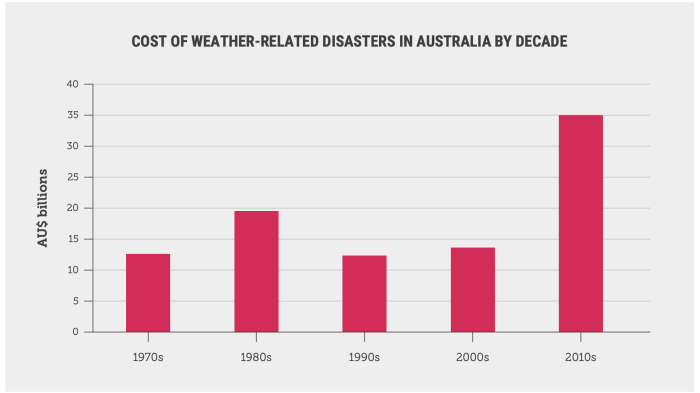
The extremes throughout 2022 were disastrous for local communities. At least 23 people died from the flooding in south-eastern Queensland and eastern New South Wales in early 2022. The State Emergency Service considered over 3,600 homes across the New South Wales northern rivers region as uninhabitable. The New South Wales State Emergency Service responded to 31,400 calls for help in the six-week period.
The floods between February and March were the costliest in Australia’s history totalling $5.56 billion in insured losses across Queensland and New South Wales. Parts of Australia’s food growing regions were affected, with damage to infrastructure, crops and loss of livestock. Supply chains were impacted, challenging food supply and increasing the price of some fruit and vegetables. These economic costs do not include the psychosocial effects associated with traumatic extreme weather events such as displacement of people from their homes, community impacts, stresses from loss of financial security or the threat of repeated events.
In Eugowra, 2 people died and more than 150 people were airlifted from building rooftops or evacuated by boats when the flash floods occurred. Most homes in the town were affected by the flood waters causing water damage to belongings, instability caused by dislodged footings, windows smashed and many items to washed away.
Rebuilding is likely to take years. The cost of weather-related disasters in Australia is increasing every decade. Whether this trend of increasing costs is related to climate change, or increased exposure to weather related disasters is not easy to disentangle.
Attributing climate change to events

Climate extremes such as heatwaves and short-duration heavy rainfall have already increased in frequency and intensity in Australia and the risk of these events increases with every fraction of a degree of warming.
Demonstrating that some major extremes are, or are not, strongly influenced by climate change can take several years to accomplish. Therefore, while these extremes are increasing that does not mean we can clearly attribute all the extreme events that occurred in 2022 to climate change.
- Some, including regional heatwaves are extremely likely to have been influenced by climate change,
- Some, such as the short-duration intense rainfall may have been,
- Some are most likely simply reflecting natural variability.
It is also possible that what we call “natural variability” is itself being influenced by climate change.
Explaining events through natural mechanisms does not imply that climate change does not play a role.
The ARC Centre of Excellence for Climate Extremes is reducing Australia’s vulnerability to these climate events by improving our understanding of how these events occur and how they will change in the future.
The State of Weather and Climate Extremes 2022
Weather and climate extremes in Antarctica
Extreme events in 2022
Heatwaves in Western Australia
Extreme rainfall and flooding in Queensland and New South Wales February-March 2022
Record low Antarctic sea ice extent in 2022
Simultaneous Antarctic and Arctic heatwaves
Collapse of East Antarctic Conger ice shelf
Hailstorms in Queensland, Victoria and New South Wales
Damaging wind gusts in South Australia and the Northern Territory
© 2023 ARC Centre of Excellence for Climate Extremes
References and acknowledgements available in the PDF version available here.
Materials used are for educational purposes and either author provided or used under fair dealing provisions.
